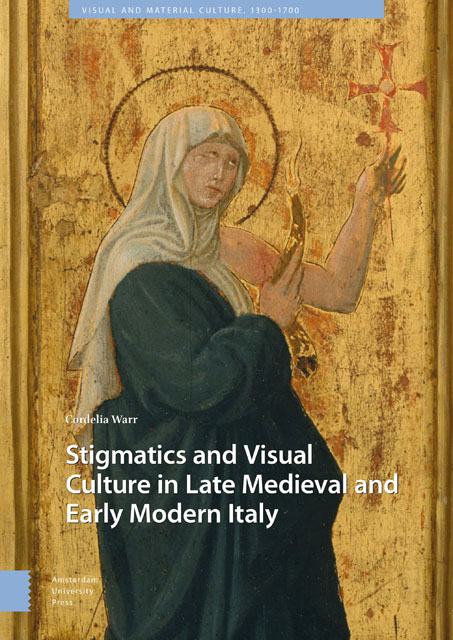Book contents
- Frontmatter
- Table of Contents
- Acknowledgements
- List of Illustrations
- 1 Introduction: Stigmata and Visual Culture
- 2 Saint Francis of Assisi as Image
- 3 Representing the Invisible: Saint Catherine of Siena’s Stigmatization
- 4 The Stigmatic Spectrum and the Visual Arts
- 5 Gregorio Lombardelli, Invisibility, and the Representation of Saint Catherine of Siena’s Stigmata
- 6 Performing Stigmata
- 7 Painting, Printing, Sculpting, Forgery (and Washing)
- 8 Conclusion: The Timidity of the Visual Arts
- Complete Bibliography
- Index
3 - Representing the Invisible: Saint Catherine of Siena’s Stigmatization
Published online by Cambridge University Press: 06 December 2022
- Frontmatter
- Table of Contents
- Acknowledgements
- List of Illustrations
- 1 Introduction: Stigmata and Visual Culture
- 2 Saint Francis of Assisi as Image
- 3 Representing the Invisible: Saint Catherine of Siena’s Stigmatization
- 4 The Stigmatic Spectrum and the Visual Arts
- 5 Gregorio Lombardelli, Invisibility, and the Representation of Saint Catherine of Siena’s Stigmata
- 6 Performing Stigmata
- 7 Painting, Printing, Sculpting, Forgery (and Washing)
- 8 Conclusion: The Timidity of the Visual Arts
- Complete Bibliography
- Index
Summary
Abstract
Representations of Catherine of Siena's stigmatization raised questions about the relationship between seeing and knowing. Catherine's stigmata were challenging. They did not appear visibly on her body, were the result of a series of separate events, and, it could be argued, were transient. The episodes associated with the stigmatization were detailed in Raymond of Capua's Legenda Maior, whilst in the Libellus de Supplemento Tommaso Caffarini discussed its representation. In this chapter, visual examples in the two extant illustrated manuscripts of the Libellus, together with Giovanni di Paolo's painting of the Stigmatization, are used as a basis from which to consider problems surrounding the depiction of Catherine's stigmatization and the ways in which these were articulated in the fifteenth century.
Keywords: invisibility, Dominicans, Tommaso Caffarini, Giovanni di Paolo, Raymond of Capua, transience
As discussed in the last chapter, the representation of Saint Francis of Assisi's (d. 1226) stigmata in visual art was contentious: not only was the miracle disputed but painting Francis with the stigmata was interpreted by some as showing the saint in a way that should have been reserved for Christ. For those who accepted the miracle, however, there was no question that Francis had visible marks on his body. The depiction of Francis with the stigmata, therefore, had a clear connection to his physical appearance after the feast of the Exaltation of the Holy Cross in 1224, even if the specifics of the appearance of those stigmata were not always faithful to the descriptions in Francis's vitae. The case was different for Saint Catherine of Siena (d. 1380), the pre-eminent Dominican stigmatic. It had been difficult for some to accept Francis as a stigmatic but, for many, it was even more problematic to accept a woman as having miraculously received the wounds of Christ. Furthermore, Catherine's wounds were invisible and were part of a series of miraculous stigmatic events that happened at different times marking her in ways that went beyond Francis's stigmata. Catherine's miraculous stigmatic experiences, for her Dominican supporters, helped to re-define stigmata in a way that made Francis part of a larger phenomenon, something I will discuss in the next chapter.
- Type
- Chapter
- Information
- Publisher: Amsterdam University PressPrint publication year: 2022



